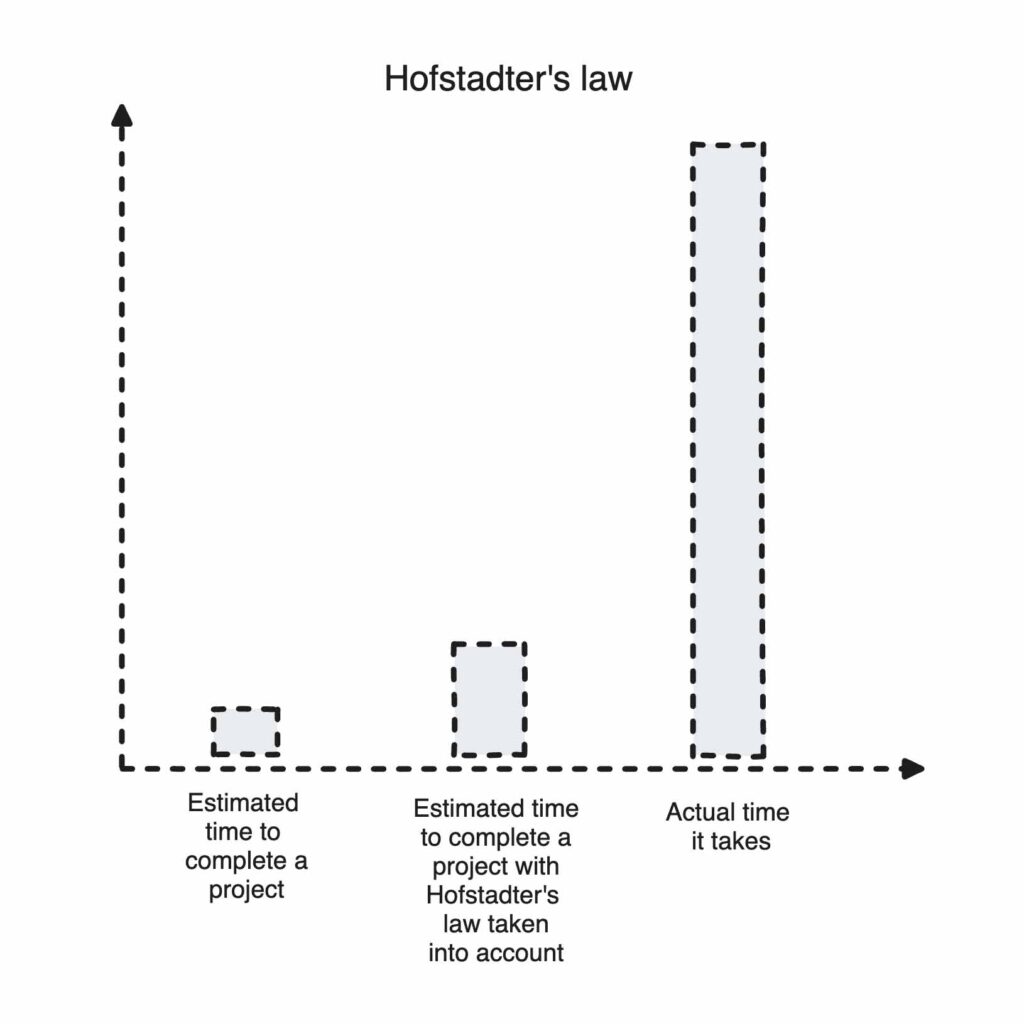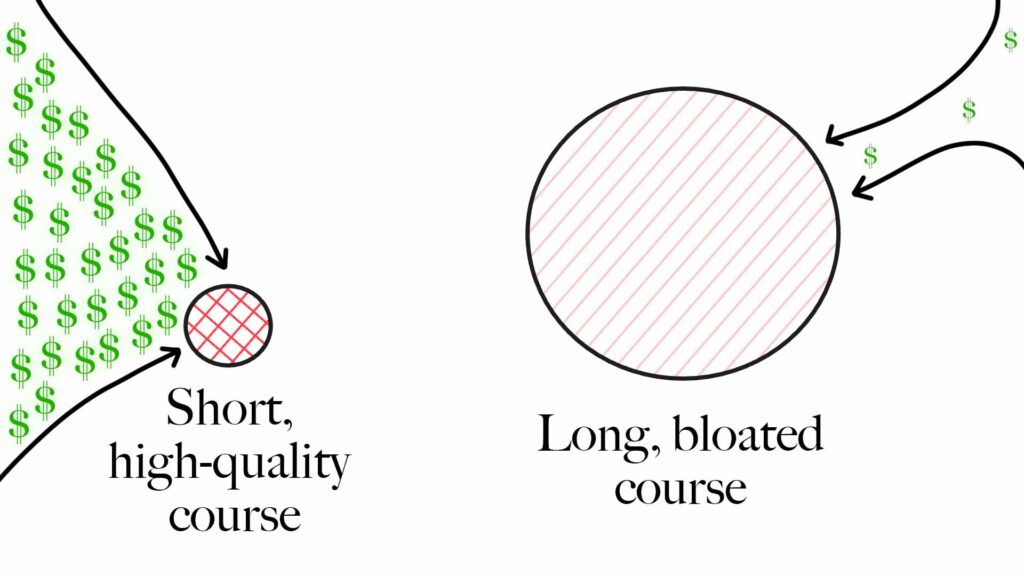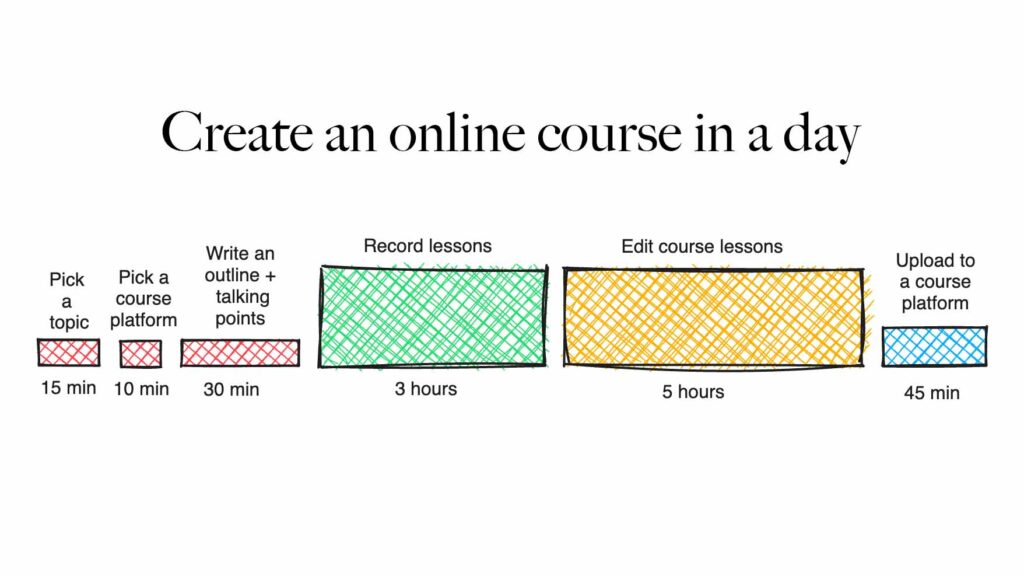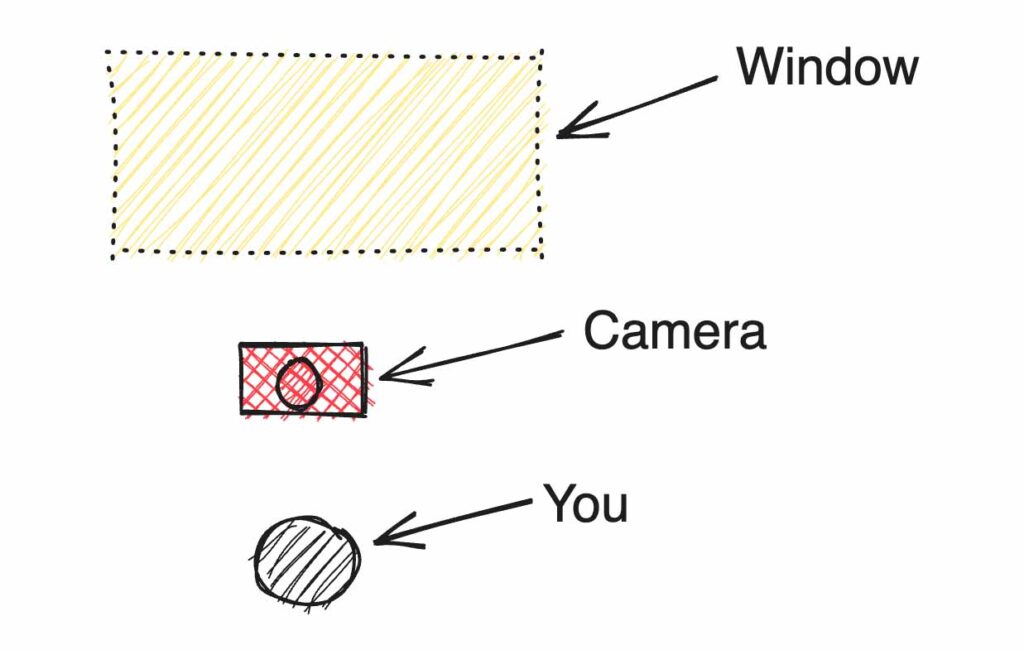How long will you spend creating an online course?
If you’re creating an online course for the first time then this is one of many important questions that could pop into your head.
It generally takes anywhere between 15 to 250 hours to create an online course.
There’s this famous law called the Hoftsadter’s law which says that a project will always take longer than you expect, even if you take this law into account.
I found this law to be true when creating most of my online courses. I now have more than 7 of them.
When you have a big project on your hands, such as creating a course, it’s easy to get into analysis paralysis and keep delaying the starting day. And that’s what often burns the most time (or feels the longest).
Once you get into the rhythm of planning and recording course lessons time flies extremely fast. But if you’re stuck in the planning phase questioning every single decision and even whether you should make a course in the first place, that’s what feels like an eternity.

How Many Hours does it take to create a full course vs a mini-course
A mini-course is just what it sounds like. It’s a small course focused on solving a niche problem for the student.
Mini-courses are often used to test out the market and whether the topic has a lot of demand or not. You can read more about how to test the course market here.
Mini-courses are usually priced between $10-$100 and the typical length for a mini-course is anywhere from 20 minutes to an hour.
Whereas a full online course is usually an hour+ in length and its price can range anywhere from $100 to $2500 in price. Find out how to price your course here.
I’ve made both, mini-courses and I have one big course called the YouTube Video Course which focuses on how to edit videos in Premiere Pro as well as start and grow a YouTube channel from scratch. And this course is more than 5 hours long.
How long did it take me to create a mini-course vs a full course?
Mini-course (30 min long), I’m using my course about how to make an amateur voiceover sound professional without expensive gear as an example here:
- Scripting – 1.5 hours per day for a week. 10.5 hours total.
- Recording the voiceover – 1.5 hours total.
- Recording the course footage – 4 hours total.
- Editing the course footage – 50 hours.
- Uploading the course to a course platform – 1 hour.
- Creating a course thumbnail – 1 hour.
- Writing a course description – 2 hours.
Total time for creating a fully scripted mini-course: 70 hours.
Long course (4+ hours), I’m using my YouTube Video Course as an example here:
- Scripting (outline only + main talking points) – 3 hours.
- Recording the course lessons – 16 hours.
- Editing the course footage – 115 hours.
- Uploading the course to a course platform – 3 hours.
- Creating an intro video – 20 hours.
- Creating a course thumbnail – 2 hours.
- Writing a course description – 2 hours.
- Designing the landing page – 7 hours.
Total time for creating a long course: 168 hours.
In conclusion, it took me 70 hours to create a fully scripted 30-minute-long mini-course and 168 hours to create a 4+ hour-long big course.
How long should you make your online course?
Should you worry about how long your online course is?
The answer is no.
Your course length doesn’t matter as long as it delivers on the promise and helps the student achieve the transformation that they are looking for.

There are many 2-hour long courses that bring in tens of thousands of dollars per month for the creator just because of the quality of the transformation that they help achieve for their students.
The person who’s buying your course isn’t paying for the length. They’re paying to solve a problem that they have.
For this reason, some online courses are marketed by putting their short length as a benefit, not a downside, for example, “The Two Hour Writer” by Dan Koe.
So focus on solving a problem that your target audience has instead of making your course as long as it can be.
Of course, sometimes creating a longer course can mean that you are able to solve the problem for your students better and help them achieve the transformation that they desire.
But the point is, that your course length doesn’t matter as long as you help your students overcome the problem that they bought the course to help solve.
How hard is it to create an online course?
Is it going to be hard to create an online course?
Well, it really depends on what you already know.
Do you know how to edit videos? Do you know how to record a professional-sounding voiceover? Are you familiar with course platforms?
If yes, then creating a course is going to be a piece of cake.
If not, then it’s going to be a little harder since you’re going to have to learn these things along the way.
If you have the skill set to create a well-polished YouTube video then it can take you anywhere from 15 to 50 hours to create a simple course.
If you’re going to be learning how to put together a video from scratch then it may take you anywhere from 25 to 200 hours to put together a course of a similar length.
If you want to learn how to make and edit videos (whether it’s for courses or for a YouTube channel) then I highly recommend checking out my YouTube Video Course.
Don’t let the name deceive you, the course material applies to creating courses just as much as it does to YouTube videos.
The ability to turn an idea in your head into video form is one of those skills that you’ll never regret having.
It helped me become my own boss from just my laptop and anywhere in the world.
You’ll learn how to edit videos in Premiere Pro from scratch, what matters in a video and more importantly, what doesn’t.
How to create an online course in a day?

Although it seems quite hard, creating a short online course in 1 day can be done.
Here’s how:
1. Choose your course topic
Pick a topic that you know in and out, that you could talk hours about.
More importantly, think of your target audience.
Consider the problems they have, what are they seeking to learn from your course, and how can you provide the most value to them.
2. Pick a course platform
Once you have a topic consider the course platform where you want to publish your course.
This step matters because some platforms such as Udemy have guidelines that you need to follow in order for your e-learning material to be accepted.
Here are some platforms that I recommend:
- Skillshare – best for short courses, has a built-in audience but strict guidelines in terms of what courses get accepted.
- Podia – best overall for hosting your course, it lets you customize your landing page, and do email marketing, but it doesn’t have a built-in audience looking for courses.
- Payhip – best platform for listing your course for free (this one also doesn’t have a built-in audience).
3. Write an outline + main talking points
Since the goal is to create a course within a day, writing a script for it is going to take too much time.
That’s why the goal is to have a rough outline in mind so that there is some sort of structure to the course and then record the lessons with that structure in mind.
Here’s what the outline could look like:
(I’m using one of my Skillshare courses about how to make a professional-sounding voiceover as an example here).
1. Introduction
– Importance of good audio
– What makes people record bad voiceovers
– What the course will teach you
2. Setting up the recording environment
– Why is the recording environment important
– How to create a good recording environment for free at home
– 5 tips to set up the recording environment the right way
3. How to speak to a microphone
– Optimal distance between your mouth and microphone
– How to find the exact location of your device’s microphone
– How to speak to sound more confident
– Smile when you speak
– How to speak to make the editing easier
4. Setting up Audacity
– What is Audacity
– How to download and install it
5. Enhancing the voice-over audio in Audacity
– How to import audio
– How to apply a limiter + what it is
– How to reduce background noise
– How a compressor works and how to use it
– How to normalize audio + what it is
– How to export audio
6. Conclusion
– Summary of the main points
– Thank the student for taking the course and encourage them to record a voiceover and apply the things they learned
4. Record Course Lessons
What usually takes the longest when creating an online course is either the recording or the editing.
That’s why we wrote the outline along with the main talking points to make the recording easier.
Now you can sit down and record everything in one go. Don’t try to make it perfect, imagine you’re talking to an old friend and just share the information you know.
By looking at the outline you’ll know exactly what to talk about without rambling.
Try to make each lesson around 3-10 minutes long.
The main goal here is to help someone learn, not to be a perfect speaker.
I record most of my online courses without showing my face. It’s either a screenshare or a top-down shot of my keyboard and my hands.
If you’re just planning to show your computer screen then the only thing you should worry about is your voice-over quality. Make sure it sounds good, clear and crisp.
If you’re recording yourself though, make sure you’re not up against a window.
Here’s an illustration that shows how to achieve good video quality without having studio lights or expensive filing gear (your phone is enough):

5. Polish up the course lessons
While recording you’ve probably made a lot of mistakes, repeated yourself a bunch of times and maybe had someone make noise in the background.
And all that creates a subpar experience for the student.
That’s why once all the lessons are recorded we’re going to polish them up with editing software.
If you’re already familiar with any kind of editing software then just use that.
What I use for editing my YouTube videos and courses is Premiere Pro. It’s quite advanced though and will probably take you a good couple of months to master if you don’t know how to use it already.
A good free alternative if you’re on a Mac is iMovie.
Once you import your course footage into your editing software of choice:
- Cut out all the silences in between words
- Remove places where you repeat yourself
- Sync your video footage with your screen share or slides (if you used any),
- Add titles and text that emphasise important points. You can get professional-looking title presets through Motion Array.
6. Upload the course to a course platform
The final step is to upload your course to a course platform of your choice.
Make sure to:
- Write a title (this guide on how to write killer titles for YouTube videos might be helpful).
- Write a brief SEO-optimized description
- Describe what your course teaches (focus on student transformation rather than just the information that they’re going to learn)
- Include a clear call to action that encourages potential students to take your course.
Was this guide about how long it takes to create an online course useful?
I hope this guide was useful.
Thanks for reading 👋.
I’ll leave you with a few more resources that will help you craft an insanely transformational online course that actually sells: